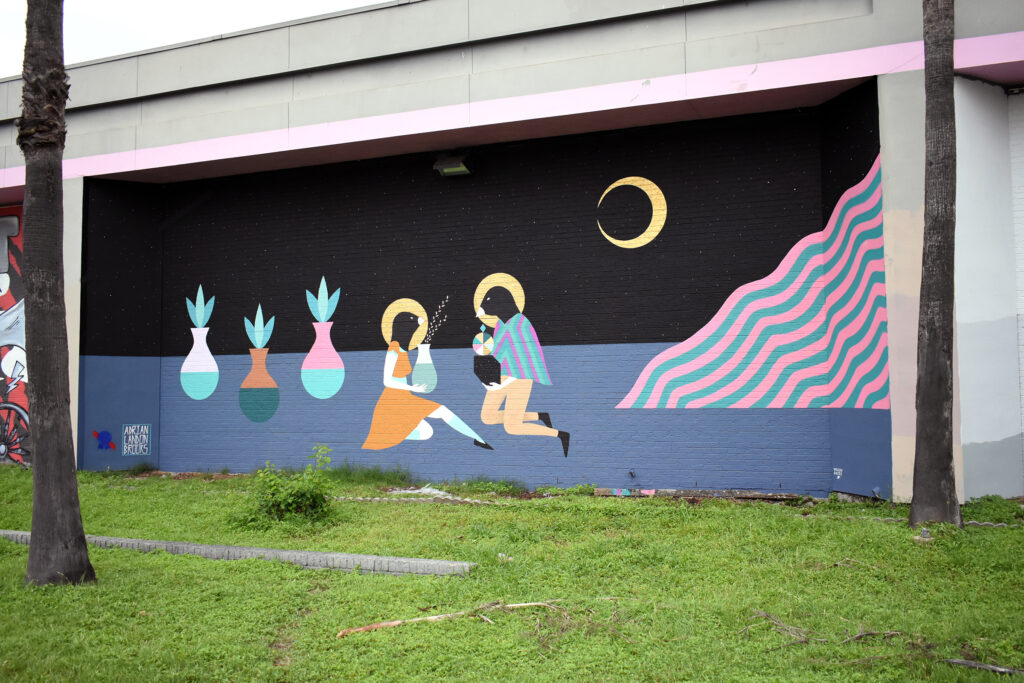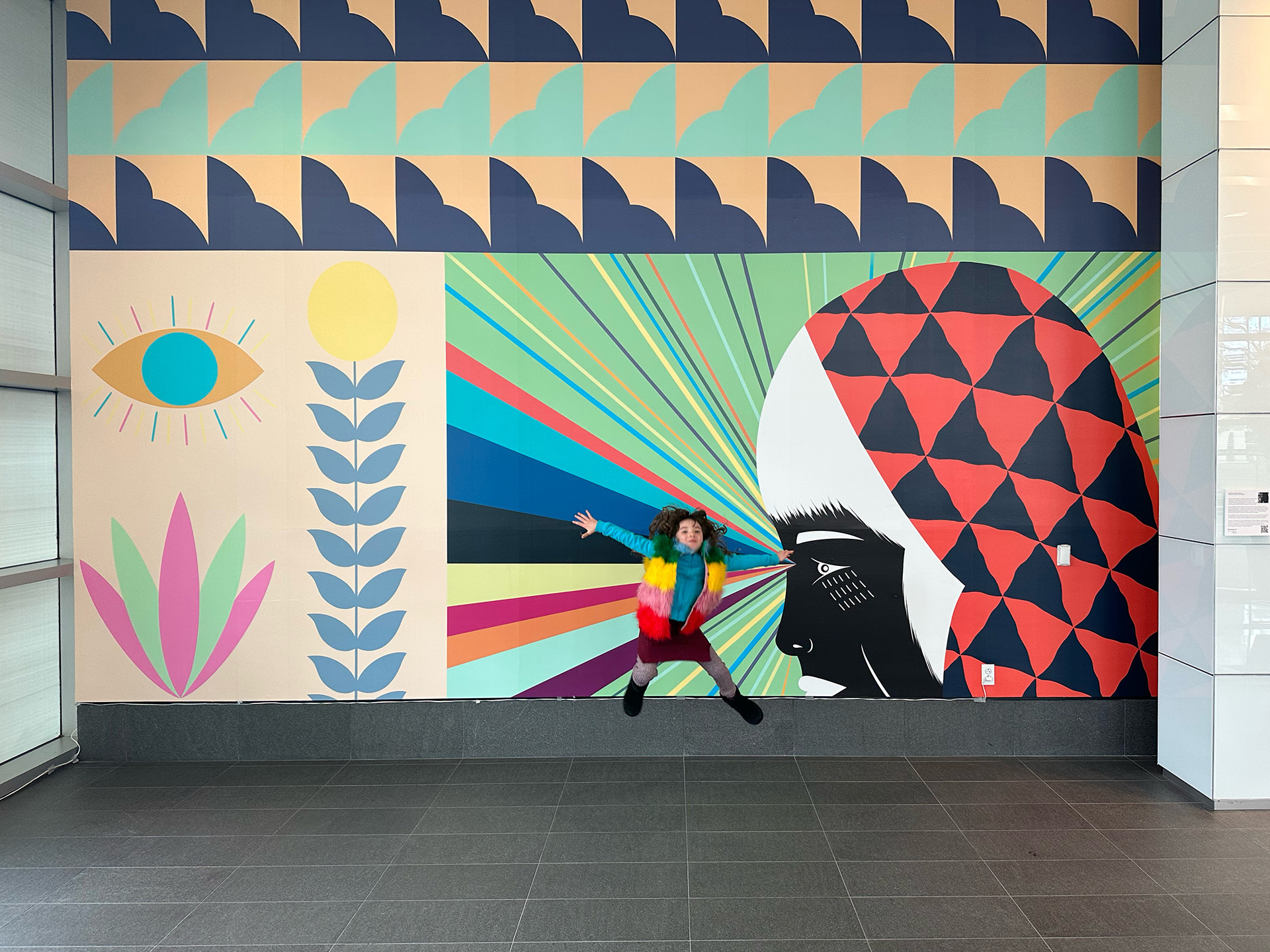From illustrations to murals with Adrian Landon Brooks
Interview with Collater
Texas, also known as The Giant for being the largest state in the USA, comes to Milan for a group exhibition at Antonio Colombo Gallery. Representing it are five artists – Adrian Landon Brooks, Sophie Roach, Esther Pearl Watson, Bruce Lee Webb, Adam Young with a special guest, musician Tom Russell – who, through birth, upbringing, or a period of their lives, have absorbed the soul and culture of Texas. In recent years, Texas has been regarded as a new frontier of art in the States. Several private institutions have emerged, renowned architects have completed various projects, collecting has grown, and the art scene has become extremely vibrant. Observing the artworks of the Texas Tornados exhibition – open from November 30th to February 3rd – we were particularly struck by the work of muralist Adrian Landon Brooks, resonating with our street-oriented exploration. We asked him a few questions to learn more about his journey.

Your murals and illustrations follow a distinct stylistic signature. The colors are flat, and, more generally, the aesthetics lean towards the esoteric. Where does the fascination for this world originate?
I remember going to an old Catholic Church as child and staring at the all the symbolism that filled the inside. I never had much of an interest in studying what those symbols meant to the people who had faith in the religion but I did find it visually fascinating even as a child. That initial interest carried on to my early work. I found myself integrating halos, hands of praise and similar iconography without much thought or intention. Now later in life that initial interest has widened to an appreciation of symbolism from many different cultures. I feel like I’ve created some of my own mythology along the way, but I still enjoy investigating what history has to offer. I have most recently been taking a deep dive in to Egyptian themes and seeing how those could relate to my creative vision. This series of work has taught me quite a bit about successful narratives in painting and the elegance in simplicity.

Is illustration a consequence of your mural practice, or are these two practices that developed simultaneously within you?
The two practices at first felt very at odds with one another and completely different creative processes. I approached my first murals somewhat mechanically and wasn’t ready to view them as part of my larger body of work. It was only with time that those two worlds started to meld together. Now my murals and studio work very much feel like extensions of one another. Both practices constantly influence one another and help my work evolve.

In your scenarios, abstractionism and narrative intertwine. The decorative nature of your textures meets figurative elements that tell stories. In each of your illustrations, is there an intent to narrate a story, or does aesthetics prevail over meaning?
I would say that I sometimes have a vague idea of a narrative within my paintings but its usually more about an overarching emotion than a complete story. I would like to have myself present in my work but also leave enough room for the viewer to have a unique interpretation. That being said, I create many works that are completely driven by composition, color and aesthetics. I enjoy the process of juxtaposing different imagery like hard edge patterns with a soft figure or plant.
The two different approaches have more to do with where I am emotionally that given day than a specific goal for the artwork. I try to leave creative direction up to the universe and follow a more subconscious path. The creative process only gets more difficult when I am trying to control every outcome. It’s a balancing act between completing an idea for a painting but also leaving room for new discoveries.

In the exhibition at Antonio Colombo in Milan, which focuses on the Texan art scene, the curation juxtaposes your work with other artists sharing your origins. What are your thoughts on this dialogue that has emerged, and what do you think about the Texan art scene? Have your origins influenced your work? Do you believe that part of your imagery stems from the place where you were born and raised?
My experience growing up in Texas is probably much different than the world view of the state. I was fortunate to grow up in one of the most diverse cities in the country and was exposed to a creative community very early on. I was originally born in Houston and spent my formative years surrounded by museums, galleries and my mother who was a working fiber artist. I eventually landed in Austin which has a long history in music but not as much when it comes to visual art. What I did find was a community that welcomed me with open arms and many artists run galleries. That specific scene was very much run by the artist community and self-efficient in many ways. This has changed some as the city has boomed in the last ten years with massive growth, but the core community has the same spirit it has always had.

Sophie and Adam were special people for me to meet in my early Austin days. They’re both very much part of the history I just described and have continued to inspire me more and more every year. I have also been a fan of Bruce and Esther’s work for years but more from a distance. It’s that much more exciting to bring us all together to share some walls and experience. I believe the work will create its own visual dialog and should be really interesting to witness.

I would say my surroundings have most influenced me in recent years. I have a habit of collecting chunks of wood and odd objects that are available because of where I live. Native Texas tree slices serve as canvases for many of my paintings. I would imagine I am drawn to that aesthetic from growing up in the South and subsequently moving to the woods with my family. We live on six acres outside of town and are surrounded by trees. I found a peaceful slice of paradise to enjoy with my family which has definitely influenced me in many ways.
Where did you create your initial mural works? There’s a noticeable meticulousness and attention to the buildings and public surfaces you work on. It’s as if your illustrations blend in, adapting to the surrounding environment, becoming an integral part of the landscape without altering it drastically or causing visual shock. What are your thoughts on this? Do you conceive the project based on observing the location?
My first professional mural was for the Meta headquarters in Austin, Texas. The company had an amazing program at the time run by curators with real passion for supporting local artists (in locations all over the world. This opportunity really shifted my career path and showed me the possibilities that existed if I took a step out of the studio and made some larger work. It’s been a tremendously rewarding process to watch how much my work has grown from experimenting with different scale and limiting circumstances. Rather than be a restrained color palette for an office or a more specific creative request from a client. All of those experiences have helped me grow as an artist inside and outside of the studio.
I would ultimately like my work to become one with the space that it inhabits so its very nice to hear its perceived that way from you. My goal with large scale murals is to take the subtleties from my studio work and expand them on a larger scale for a larger audience. I believe it’s possible to capture the same meaning and spirit regardless of the size. I spend quite a bit of time visiting the site and making digital renderings of proposed ideas on actual photos of the space. This process helps me to consider all the existing elements at play within the space and how my artwork will interact with the surroundings.

